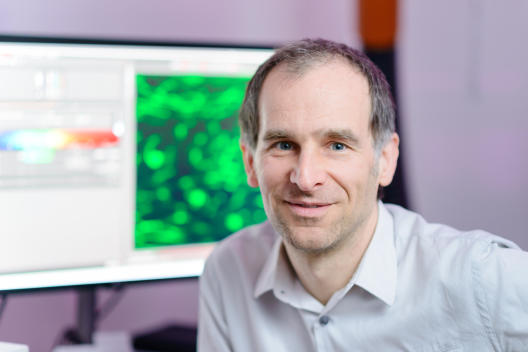The long road to new knowledge

Prof. Stefan Luschnig discovered a protein. Thanks to this protein, three cells can form stable contacts. This is imperative when cells form tissues, for example in blood vessels. How does Stefan Luschnig know this? With an international eleven-member team, Stefan Luschnig – a biologist – worked for five years on finding this protein in the fruit fly Drosophila and understanding its role. This work carried out by the researchers is a typical example of the often long and tedious process that leads from an initial idea to a reliable result.
At the beginning, it was not even clear whether such a protein actually existed: “We know very little about how cells form this special type of contacts,” explains Stefan Luschnig, a professor at the Cells-in-Motion Cluster of Excellence. He undertakes basic research at the Institute of Neuro- and Behavioural Biology at the University of Münster, investigating cellular mechanisms that might also play a role in the human body in the origin of certain vascular diseases.
For half a year, students taking doctoral and masters degrees randomly inactivated genes in thousands of fruit flies. In this case, this process was more efficient than testing one gene after another. “The unbiased approach can sometimes be surprisingly successful,” says Stefan Luschnig.
The biologist analysed the fruit flies’ tracheal system, which, in certain aspects, resembles human tubular organs, such as blood vessels. Inactivating the genes produced mutants, which were no longer able to form functional tracheal tubes. “In these defective flies we studied the genes we had inactivated, and how this affected the development of the tracheal system,” Luschnig explains. He and his team scored a hit in 2011: one gene contained the assembly instructions for a protein, which normally accumulates at the sites where three cells meet up. If the gene was missing, the fruit flies could not form functioning organs. “The cell contacts, which are normally tightly closed, were as permeable as a sieve,” says Luschnig. He calls this protein a component of the “tricellular junction”.
This was an exciting finding, but it was only here that the actual work really started. “Scientists constantly question their results,” says Stefan Luschnig. “That’s one of the principles of good scientific practice.” The Münster researchers sent their mutant fruit flies to a Swedish research group they were collaborating with. The idea was for them to look at the mutants without having any indication of the results the team in Münster had arrived at. A blind test, so to speak. “They arrived at the same conclusion,” says Stefan Luschnig.
However, this was just the kick-off for another four years of hard work. “The aim we had set ourselves was to understand how the proteins travel within the cell to arrive at the three-cell contacts,” says Stefan Luschnig. “To this end, we carried out experiments to systematically test a variety of possible explanations.”
They performed around one hundred experiments, documented in detail, in which the researchers analysed the protein bit by bit. “We questioned our hypothesis again and again,” says Luschnig. Some of the experiments did not provide much information, others failed, and the successful ones had to be repeated in order to ensure that the results were reliable.
There were also many smaller milestones. The researchers published their results in scientific journals, presented them at meetings and discussed them with colleagues. “Thanks to the many suggestions we received – especially from colleagues in other disciplines – we were able to provide solid evidence for our discovery,” says Stefan Luschnig. Only when they had reached this stage did the team collate all their findings in a scientific paper. Again and again they had to return to the laboratory to test every possible new explanation in experiments.
The group wanted to provide evidence that was as substantiated and as clear-cut as possible. For example, they wanted to understand the route the protein takes in cells in the living animal. “What happens in cultured cells does not always fully reflect the situation in vivo – in our case, the living fruit fly,” he explains. “In general, in vivo experiments take more time – but they often provide the most convincing evidence.”
Finally, the aim was for a scientific journal to publish the paper on the tricellular junction. “Scientific journals have strict selection criteria,” says Stefan Luschnig. Before any paper is published, at least two specialists critically review its content. “After the reviews we had to provide further evidence and test other possible explanations.” After another six months, all the critical questions had been answered and the researchers’ work was ready for publication in the journal “Developmental Cell”. After spending five years doing research, the team had reached a milestone. They had identified a key component of the “tricellular junction” and proposed a mechanism for the formation of this structure.
Original publication:
Byri S, Misra T, Syed ZA, Batz T, Shah J, Boril L, Glashauser J, Aegerter-Wilmsen T, Matzat T, Moussian B, Uv A, Luschnig S. The Triple-Repeat Protein Anakonda Controls Epithelial Tricellular Junction Formation in Drosophila. Dev Cell 2015;33: 535-548. Abstract
Prof. Stefan Luschnig at the Cluster of Excellence
March for Science:
Concerned researchers and citizens around the world are taking to the streets on Saturday the 22nd of April. Their goal: to demonstrate in a "March for Science" that the results of scientific research, not opinions and alternative facts, should inform public debate. Read all articles on the subject on the Münster University's website

